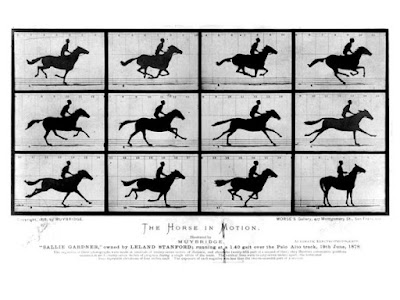In 1826, French scientist Joseph Nicéphore Niépce, took that photograph, titled View from the Window at Le Gras, at his family’s country home. Niépce produced his photo—a view of a courtyard and outbuildings seen from the house’s upstairs window—by exposing a bitumen-coated plate in a camera obscura for several hours on his windowsill.
First Color Photograph
Scottish physicist James Clerk Maxwell produced the first color photograph in 1861. Maxwell created the image of the tartan ribbon shown here by photographing it three times through red, blue, and yellow filters, then recombining the images into one color composite.
First Photos of Movement
In 1878, Muybridge arranged 12 trip-wire cameras along a racetrack in the path of a galloping horse. The resulting photo sequence proved that there is a point when no hooves touch the ground and set the stage for the first motion pictures.
First Nighttime Animal PhotosThis flashlight photograph of a white-tailed doe with her fawns was among the world’s first nighttime photographs of animals, shot by photographer and wildlife enthusiast George Shiras. A pioneer in flashlight and trip-wire photography, Shiras captured this shot in Whitefish River, Michigan, around 1906, using a remote-control flashlight camera triggered when an animal stepped on the trip wire.
First Photo of the North Pole
In April 1909, Admiral Robert Peary and his team (pictured here), including Inuits Ooqeah, Ooatah, Egingwah, and Seeglo and fellow American Matthew Henson, became the first explorers to reach what they believed to be the North Pole. Later studies found that Peary was actually 30 to 60 miles (50 to 100 kilometers) short of the Pole.
First Underwater Color Photo
Dr. William Longley and National Geographic staff photographer Charles Martin photographed this hogfish, off the Florida Keys in the Gulf of Mexico, in 1926. Equipped with cameras encased in waterproof housing and pounds of highly explosive magnesium flash powder for underwater illumination, the pair pioneered underwater photography.
First Archaeology Photos
In 1912 Yale University professor and explorer Hiram Bingham was searching in the Peruvian Andes for the ancient Inca capital of Vilcabamba when he and his guide stumbled onto one of the greatest archaeological finds in history. Thanks to his photographs of the lost city of Machu Picchu, Bingham and National Geographic helped bring archaeology out of the field and into people’s homes.
Oldest Known Photograph of a Tornado
An unknown photographer captured the earliest known photograph of a tornado. The black-and-white image was taken on August 28, 1884, about 22 miles (45 kilometers) southwest of Howard, South Dakota.
Source: National Geographic








No comments:
Post a Comment